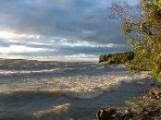Huron first spotted monster in Simcoe
Huron first spotted monster in Simcoe
Blast from the Past
Weird things have been seen in the waters of Lake Simcoe for hundreds of years. A creature -- a sea serpent, if you will -- is said to inhabit its depths.
One might be inclined to question the lucidity of any claiming to have seen a Loch Ness-style monster, but can dozens of witnesses all be hallucinating or lying?
For a moment, let's assume the creature known today as Kempenfelt Kelly does exist. What is it? The most credible theory is that it's a dinosaur, some sort of surviving prehistoric creature. Certainly, there is evidence the creature has been around for hundreds of years.
The Huron Indians believed a monster of some sort inhabited the depths of Lake Simcoe. Their name for it was Mishepeshu and it was a name they uttered only in hushed tones.
They believed Mishepeshu to be an angry and murderous spirit, a creature willing to feast on human flesh if sufficiently riled. The creature was identified as having a dog-like head topped by curved horns, a long serpentine body and a slender tail.
Eerily, that description is remarkably similar to that given by witnesses over the past two centuries.
The first written description appears in 1827, when David Soules spotted the creature from shore: "It was a huge long thing that went through the water like a streak, having huge fin-like appendages and being very large and very ugly looking."
It was a fleeting glimpse. As suddenly as the creature had appeared, it slipped beneath the water once more and was gone. The whole experience had lasted mere moments, but it haunted Mr. Soules for a lifetime.
A fleeting glimpse -- that seems to be all eyewitnesses get. But there are exceptions. Case in point: Cook's Bay, 1991.
It was a beautiful summer's day and the waters of the lake were crystalline and placid. A cameraman was on shore videotaping his friend as he raced his boat across the bay. Suddenly, the craft broke down.
While the boater began repairs, something quietly surfaced mere metres away. At first, the creature rose out of the water on a long neck, then it slowly sunk back into the water and peered upward at the boater with only the top of its head visible above the surface. A few moments later, it submerged and did not return.
Incredibly, the whole episode was captured on film. The quality of the video images were excellent and were subsequently studied by cryptozoologists. The consensus: something unusual, something non-native to the region, definitely resides within Lake Simcoe.
For the dozens, perhaps hundreds of eyewitnesses, this merely confirmed what they already knew.
Kelly has been seen across Lake Simcoe, from Cooks Bay in the south to the Narrows at Orillia in the north. In recent years, it seems she has most frequently been sighted in or around Kempenfelt Bay, hence her name.
This perhaps makes sense. Kempenfelt Bay is the deepest part of the lake, so it's perhaps natural a creature attempting to elude discovery would reside here. In fact, local lore suggests that there are underwater tunnels beneath Kempenfelt Bay that link Lake Simcoe to other large bodies of water in Canada and perhaps even to Loch Ness in Scotland.
Unlikely though it might be, this "theory" would at least account for the reports of similar aquatic monsters in these widely dispersed lakes and explain how a genetic pool large enough to support a viable population exists.
It's important to note many credible sightings occurred throughout the 19th century, well before the Loch Ness Monster became so popular in the past 75 years. This isn't a case of people wanting to create an Ontario Nessie.
Skeptics, of course, will claim all sightings can be dismissed as either hoax, hallucination or misidentification.
But there's a fourth option, one the romantic in me chooses to entertain: reality.
History buff Andrew Hind can be reached at maelstrom@sympatico.ca



